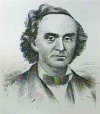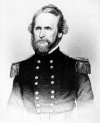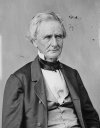St. Louis Arsenal

 |
 |
 |
 |
As early as January in 1861, pro-Southern factions were advising Governor Jackson to seize the military stores at the St. Louis Arsenal. On January 24th, Brigadier-General Daniel M. Frost, commander of the State Militia, sent a letter to Jackson describing his meeting with U. S. Major William H. Bell, who was the commanding officer in charge of the arsenal. Frost assured Jackson that Major Bell was sympathetic with their cause and would yield the arsenal to State authorities. Word of plots against the arsenal reached U. S. General-in-Chief Winfield Scott, and he began to shift Federal forces to its defense. Major Bell was relieved of command and replaced by Major Peter V. Hagner. Lieutenant Thomas W. Sweeny was ordered to St. Louis and subsequently issued orders restricting who could gain access to the arsenal.[5]
 |
 |


But Frank Blair finally got a key ally on February 6th, when Captain Nathaniel Lyon arrived in St. Louis with a company of U. S. Regulars from Fort Riley, Kansas. Blair had used his political connection to President Lincoln to effect Lyon's reassignment to St. Louis.[6]
Frank Blair continued to be concerned that Governor Jackson and his supporters had their eye on the military supplies stored at the St. Louis Arsenal. On March 11th, Blair sent a message to Secretary of War, Simon Cameron, requesting that Captain Nathaniel Lyon be placed in command of the U. S. forces charged with the defense of the Federal Arsenal in St. Louis. Cameron issued the order on March 13th.[7]


Everyone's fears were realized on April 12th, when the Confederates initiated open warfare by firing on the Federal garrison at Fort Sumter. Three days later, President Lincoln issued his proclamation calling for 75,000 volunteers from the states to suppress the rebellion. Each state in the Union would be expected to fill a quota of volunteers. Missouri's quota was to be 3,123 volunteers.[8]
On April 17th, Governor Jackson sent the following response to U. S. Secretary of War, Simon Cameron, regarding Lincoln's proclamation:[9]
Sir: Your dispatch of the 15th instant, making a call on Missouri for four regiments of men for immediate service, has been received. There can be, I apprehend, no doubt but the men are intended to form a part of the President's army to make war upon the people of the seceded States. Your requisition, in my judgment, is illegal, unconstitutional, and revolutionary in its object, inhuman and diabolical, and cannot be complied with. Not one man will the State of Missouri furnish to carry on any such unholy crusade.

Now U. S. Brigadier-General William S. Harney, commander of the Department of the West, was becoming concerned about the safety of the St. Louis Arsenal. On April 16th, Harney sent a message to army headquarters warning that he had received reliable information that Governor Jackson was planning on establishing batteries the hills above the arsenal. This would make defending the arsenal untenable. In the meantime, Captain Nathaniel Lyon was working hard to ship the arms stored at the St. Louis Arsenal to safety in Springfield, Illinois.[10]
On April 17th, Frank Blair sent a message to U. S. Secretary of War Simon Cameron requesting authorization to muster independent companies and regiments as volunteers into Federal service. After Missouri Governor Jackson's response to Lincoln's proclamation, Blair knew that Jackson would never accept any Missouri volunteers into Federal service. He also warned that the secessionists were planning to occupy the high ground above the arsenal, which would make defending the arsenal very difficult. On April 21st, Blair received a message stating that the Secretary of War had authorized Captain Nathaniel Lyon to muster in the volunteers available in St. Louis.[11]

On April 17th, Governor Jackson sent a letter with two emissaries to Jefferson Davis to request military aid from the fledgling Confederate States of America. Although Jackson's letter has not been found, the following reply from Davis makes it clear that the Missouri State Guard was planning to attack the Federal Arsenal at St. Louis, Missouri:[12]
A misplaced but generous confidence has, for years past, prevented the Southern States from making the preparation required by the present emergency, and our power to supply you with ordnance is far short of the will to serve you. After learning as well as I could from the gentlemen accredited to me what was most needful for the attack on the arsenal, I have directed that Captains Greene and Duke should be furnished with two 12-pounder howitzers and two 32-pounder guns, with the proper ammunition for each. These, from the commanding hills, will be effective, both against the garrison and to breach the inclosing walls of the place. I concur with you as to the great importance of capturing the arsenal and securing its supplies, rendered doubly important by the means taken to obstruct your commerce and render you unarmed victims of a hostile invasion.
We look anxiously and hopefully for the day when the star of Missouri shall be added to the constellation of the Confederate States of America.
Events were definitely continuing to heat up in April of 1861. On April 20th, a group of armed, pro-Southern men seized the Federal arsenal in Liberty, Missouri, capturing about 1,500 arms and some cannon. Brigadier-General Harney was relieved of the command of the Department of the West. Captain Nathaniel Lyon was ordered to “arm the loyal citizens, to protect the public property, and execute the laws.” In addition, Lyon was told to expect reinforcements to arrive in the form of two or three regiments of Illinois militia.[13]
On April 30th, Captain Nathaniel Lyon received the following authorization from the United States War Department[14]
The President of the United States directs that you enroll in the military service of the United States the loyal citizens of Saint Louis and vicinity, not exceeding, with those heretofore enlisted, ten thousand in number, for the purpose of maintaining the authority of the United States; for the protection of the peaceable inhabitants of Missouri; and you will, if deemed necessary for that purpose by yourself and by Messrs. Oliver T. Filly, John How, James O. Broadhead, Samuel T. Glover, J. Wilzie, and Francis P. Blair, jr., proclaim martial law in the city of Saint Louis.
Back: Prologue to The Battle of Boonville
Next: Camp Jackson
